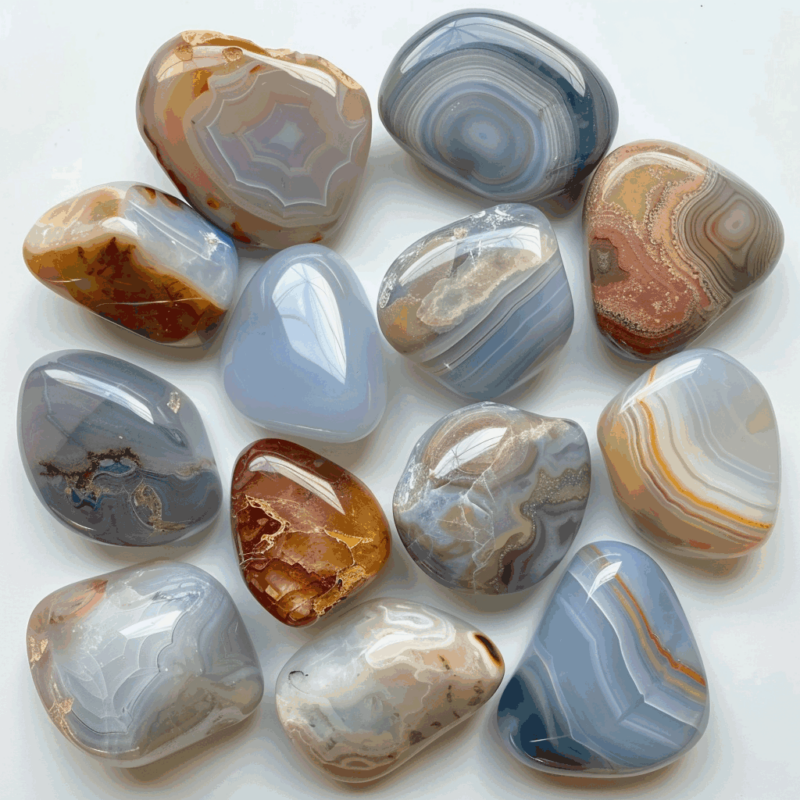ブログ
古代の伝説から現代の魔法まで:カルセドニー・ストーンの物語
Chalcedony stone, with its mesmerizing colors and unique properties, has captivated humans for centuries. This semi-precious gemstone belongs to the quartz family and is known for its translucent appearance and smooth texture. Its name is derived from the ancient Greek city of Chalcedon, where it was first discovered. Chalcedony stone has a rich history, deeply rooted in ancient mythology and civilizations. Today, it continues to be highly valued in jewelry, healing practices, and contemporary design.

The Origins of Chalcedony Stone
Chalcedony stone has a fascinating geological origin. It is formed through the deposition of silica-rich solutions in cavities or fractures of rocks. Over time, these solutions solidify and create the intricate patterns and colors that make chalcedony stone so unique. The stone can be found in various locations around the world, including Brazil, India, Madagascar, and the United States.
Chalcedony Stone in Ancient Mythology
Chalcedony stone holds a significant place in ancient mythology. In Greek mythology, it was believed to be the tears of the goddess Venus, which turned into stone upon touching the ground. The stone was also associated with the moon and was believed to bring good fortune and protection to sailors. In ancient Egypt, chalcedony stone was considered a powerful talisman that protected against evil spirits and brought harmony and balance to the wearer.
Chalcedony Stone in Ancient Civilizations
Chalcedony stone played a prominent role in various ancient civilizations. In Mesopotamia, it was used to create seals and amulets, symbolizing power and protection. The ancient Romans used chalcedony stone for carving intricate cameos and intaglios, showcasing their craftsmanship and artistic skills. In ancient China, chalcedony stone was highly valued for its healing properties and was used in traditional medicine.
The Properties and Characteristics of Chalcedony Stone
Chalcedony stone is known for its unique properties and characteristics. It has a hardness of 6.5-7 on the Mohs scale, making it durable and suitable for everyday wear. The stone is translucent to opaque, with a waxy luster that enhances its beauty. Chalcedony stone comes in a wide range of colors, including blue, pink, white, gray, and brown. Its smooth texture and vibrant colors make it a popular choice for jewelry and ornamental use.
もっと詳しく:http://mysticblast.com/harnessing-the-power-of-crystal-stones-a-guide-to-healing-and-energy

Chalcedony Stone in Jewelry and Ornamental Use
Chalcedony stone has been used in jewelry and ornamental pieces for centuries. Its versatility and beauty make it a favorite among designers and artisans. Chalcedony stone is often cut into cabochons, beads, and faceted gemstones to create stunning necklaces, bracelets, earrings, and rings. Its translucent nature allows light to pass through, creating a captivating glow. Chalcedony stone is also used in decorative objects such as vases, bowls, and sculptures, adding a touch of elegance to any space.
Chalcedony Stone in Healing and Metaphysical Practices
Chalcedony stone is believed to possess various healing and metaphysical properties. It is said to promote emotional balance, calmness, and inner peace. The stone is also believed to enhance communication skills and foster positive relationships. In crystal healing, chalcedony stone is used to alleviate stress, anxiety, and depression. It is also believed to strengthen the immune system and promote overall well-being.
Famous Chalcedony Stone Artifacts and Artworks
Throughout history, chalcedony stone has been used to create remarkable artifacts and artworks. One notable example is the famous “Chalcedony Lion” from the ancient city of Nimrud, now located in modern-day Iraq. This intricately carved lion statue showcases the skill and craftsmanship of the ancient Assyrians. Another famous chalcedony stone artifact is the “Chalcedony Cup” from the 16th century, which is adorned with intricate engravings and was once owned by the Holy Roman Emperor Rudolf II.
Chalcedony Stone in Modern Gemology
In modern gemology, chalcedony stone is highly valued for its beauty and versatility. Gemologists classify chalcedony stone into various types based on its color and patterns. Some popular types include blue chalcedony, agate, and carnelian. Chalcedony stone is also used as a birthstone for those born in June, symbolizing love and harmony. Gemologists use advanced techniques to enhance the stone’s natural colors and patterns, creating exquisite pieces of jewelry.
Mining and Sourcing of Chalcedony Stone
Chalcedony stone is mined from various locations around the world. Brazil is one of the largest producers of chalcedony stone, particularly blue chalcedony. Other significant sources include India, Madagascar, and the United States. Ethical sourcing and responsible mining practices are essential to ensure the sustainability of chalcedony stone. Many jewelry brands and designers prioritize working with suppliers who adhere to strict ethical and environmental standards.
Chalcedony Stone in Contemporary Fashion and Design
Chalcedony stone continues to be highly sought after in contemporary fashion and design. Designers incorporate chalcedony stone into their collections, creating unique and statement pieces. The stone’s vibrant colors and smooth texture add a touch of elegance and sophistication to any outfit. Chalcedony stone is also used in interior design, with designers incorporating it into furniture, lighting fixtures, and decorative objects.
Conclusion: The Enduring Allure of Chalcedony Stone
From ancient legends to modern magic, chalcedony stone has stood the test of time. Its rich history, unique properties, and captivating beauty have made it a beloved gemstone throughout the ages. Whether worn as jewelry, used in healing practices, or incorporated into contemporary design, chalcedony stone continues to enchant and inspire. Its enduring allure is a testament to the timeless appeal of this remarkable gemstone.
もっと詳しく:http://mysticblast.com/the-mystical-aura-of-tiger-eye-a-gemstone-for-the-bold-and-brave
